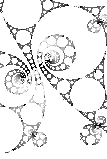

 Right: 2 Java
Right: 2 Java
| Up: Jim Morey's Table of Contents | ||

|

|
 Right: 2 Java
Right: 2 Java
|

 RESEARCH
RESEARCH
 My Master's essay was an introduction to kleinian groups.
My supervisor for that was
Bill Casselman.
I looked into automatic groups and finite state machines. The main reading
was the paper "Limit sets of free two-generator kleinian groups"
(see
a part of David Wright's page). There are two heads to these
limit sets: algebra, and geometry. I wrote some
programs to
generate the limit sets. These
programs exploit the algebra of the kleinian groups to produce the pictures.
My Master's essay was an introduction to kleinian groups.
My supervisor for that was
Bill Casselman.
I looked into automatic groups and finite state machines. The main reading
was the paper "Limit sets of free two-generator kleinian groups"
(see
a part of David Wright's page). There are two heads to these
limit sets: algebra, and geometry. I wrote some
programs to
generate the limit sets. These
programs exploit the algebra of the kleinian groups to produce the pictures.
 The geometry introduced by Schotty groups explains the patterns you get--for
instance whether it's connected or like cantor dust.
In a way, the definition of Schottky groups describe
a Iterated Function System that produces fractals. One of the big problems
of with using the definition is that it is not clear how to retrieve a set
of simple closed curves that satisfy the requirements if you start with the
transformations. Since we are dealing with Möbius transformation it seem
reasonable to just consider circles to be the curves in question unfortunately
there are Schottky groups that can not be represented by circles--even for
two-generator kleinian groups there are examples that need curves other than
circles. One plausibly way to retrieve the curves would be to compute the
limits and draw in two curves and throw them at the generators of the groups
and see if they satisfy the properties of the Schottky group. This would seem
to work and give you well behaved curves.
The geometry introduced by Schotty groups explains the patterns you get--for
instance whether it's connected or like cantor dust.
In a way, the definition of Schottky groups describe
a Iterated Function System that produces fractals. One of the big problems
of with using the definition is that it is not clear how to retrieve a set
of simple closed curves that satisfy the requirements if you start with the
transformations. Since we are dealing with Möbius transformation it seem
reasonable to just consider circles to be the curves in question unfortunately
there are Schottky groups that can not be represented by circles--even for
two-generator kleinian groups there are examples that need curves other than
circles. One plausibly way to retrieve the curves would be to compute the
limits and draw in two curves and throw them at the generators of the groups
and see if they satisfy the properties of the Schottky group. This would seem
to work and give you well behaved curves.
Recently, I have been looking more at discrete math. In particular, the algebraic stuctures of rolling solids. These turn out to have some pretty exotic algebraic structures. For instance, a rolling octahedron has both a quasi-group and a groupoid structure. Here is a partial picture of the rolling pattern of the octahedron.

|

|
| home | Contents |